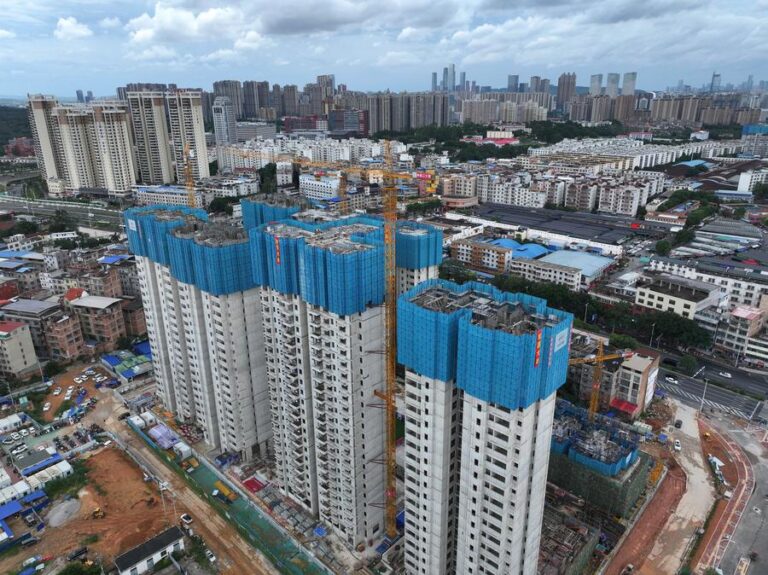BEIJING, Nov. 13 (Xinhua) — China’s real estate sector, long regarded as a pivotal engine for economic growth, is evolving to focus more on meeting people’s need for quality housing, with a policy-backed transition set to deepen over the next five years.
The Communist Party of China (CPC) Central Committee has recently released its recommendations for formulating the 15th Five-Year Plan (2026-2030), framing the goal of “high-quality real estate development” under the overarching goals of “ensuring and improving public well-being and promoting common prosperity for all.”
China’s urban growth is transitioning from large-scale incremental expansion to a stage focused on improving the quality and efficiency of existing capacity, according to the Central Urban Work Conference held in July.
In the 2021-2025 period, China’s existing housing market continued to expand, with secondary home transactions surpassing new home sales in 15 provincial-level regions, data from the Ministry of Housing and Urban-Rural Development showed.
While remaining vital to expanding domestic demand due to its deep ties to many other industries, China’s real estate sector will increasingly focus on ensuring public well-being and elevating housing quality, said Zhang Dawei, chief analyst with real estate agency Centaline Property.
ACCESS TO ESSENTIAL HOUSING
The recommendations call for optimizing government-subsidized housing supply to meet the basic needs of urban salaried workers and families in need, while the 14th Five-Year Plan emphasized effectively expanding the scale of such housing.
This shift signifies a move beyond mere quantity toward a balanced emphasis on both quality and structure, marking a new phase of high-quality development for China’s affordable housing, said Wang Yeqiang, a researcher with the Chinese Academy of Social Sciences.
Since 2021, more than 11 million units of affordable and resettlement housing, including those for the redevelopment of “urban villages” and dilapidated residential areas, have been constructed across the country, benefiting over 30 million residents.
In the 2026-2030 period, China will optimize affordable housing supply in terms of scale, regional distribution, housing types and quality, adopting a more tailored local approach, the China Index Academy noted.
New city dwellers and young people now have higher expectations regarding living conditions — and providing such people with decent but affordable housing is essential in helping them settle down in cities and unlocking their consumption potential, said Li Yujia, chief researcher at the Guangdong Housing Policy Research Center.
Zhang suggests that in addition to improving the quality of affordable housing, efforts should also be made to enhance community facilities and services — including those for education, healthcare and transportation.
From both a medium- and long-term perspective, accelerated rollout of affordable housing relending, together with demand unleashed by the cash compensation approach in urban village renewal, will provide new momentum for the market, said Zhang Bo, a researcher with 58.com.
PURSUIT OF “QUALITY HOMES”
The recommendations said city-specific policies should be adopted to increase supply to meet people’s needs for better housing. They call for building more houses that are safe, comfortable, eco-friendly and smart, and for carrying out projects to improve housing quality and initiatives to enhance property services.
This marks the first time that the concept of “improving housing quality” has been included in the recommendations for a five-year plan.
In March, the phrase “quality homes” was featured in the government work report for the first time. On May 1, new national standards for residential projects took effect — putting the improvement of housing quality in China on a faster track.
The “quality homes” initiative represents a pivotal opportunity for regional housing markets to transition from extensive growth to a high-quality development model, said Zhang Guangli, an associate professor at the Central University of Finance and Economics, which is located in Beijing.
The pursuit of “quality homes” does more than elevating living standards, as it guides a structural shift in market supply and optimizes urban layout — paving the way for more stable growth in the housing sector, he said.
Many cities have proactively adjusted their land supply structures by reducing overall volume and focusing on premium plots. A growing number of “small but refined” parcels are being released to better support high-quality residential development.
In Hangzhou, capital city of east China’s Zhejiang Province and a major regional property market, about 90 percent of residential land parcels sold this year have a planned construction area of less than 90,000 square meters. These plots typically feature complete supporting infrastructure and moderate floor area ratios — making them well-suited for building quality homes.
As the expansion of “quality homes” continues, it is expected to foster a virtuous cycle of supply and demand in the housing market. This, in turn, is creating a new playing field for companies that prioritize quality, technology and services, said Cao Jingjing, another researcher with the China Index Academy.
The recommendations also note that full life-cycle safety management systems should be introduced for housing. “This requires real estate developers to focus not only on construction quality — but also on strengthening after-sales services and property management, which will enhance the living experience for residents,” said Zhang Dawei.
The construction of new “quality homes” promotes high-quality development in this sector, while the renovation of old residential areas to meet this standard significantly contributes to stimulating investment and consumption, expanding domestic demand and enhancing public well-being, said Cao. ■

